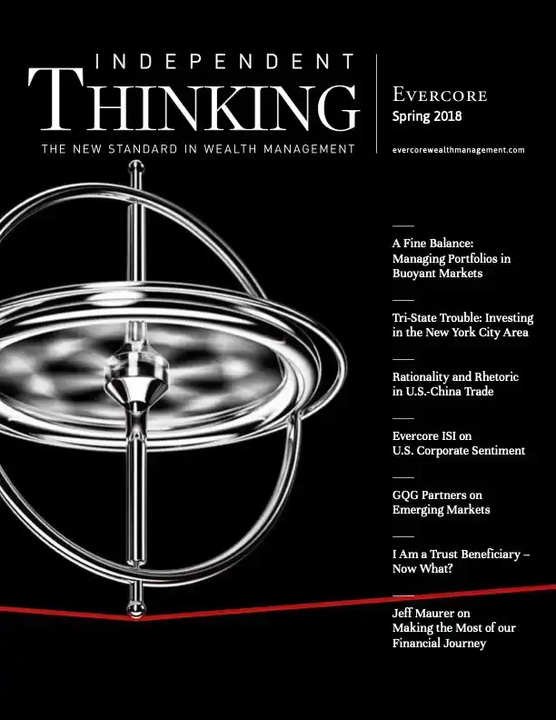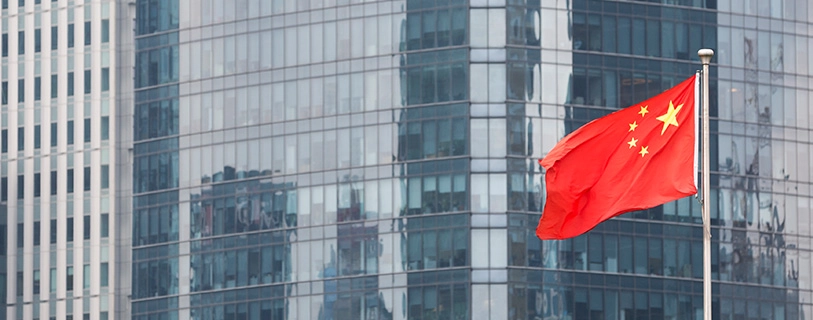Editor’s note: Neo Wang is the lead China economist/strategist at Evercore ISI, the leading U.S. research firm according to Institutional Investor’s annual survey.1 Evercore Wealth Management has limited investments in China, all of which are made through broader emerging market mutual funds.
Beijing is focused on building China into a leading modern socialist country, measured by both composite national strength and international influence, by the 100th anniversary of the People’s Republic of China, or PRC. The founding of the PRC in 1949 ended the century of humiliation, as Beijing puts it. So, what will it take to get there – and what will that mean for investors in the interim?
Composite national strength hinges on productivity.
Economics 101 taught us that output equals labor force times productivity. On one side, China, the major country that is aging the fastest, is experiencing a decades-long secular decline in its labor force. The phaseout of the one-child policy completed in 2015 has hardly helped to revive the birth rate and, in any case, it still takes at least 16 years to raise labor. The idea of raising retirement ages, a seemingly instant solution, has met with strong resistance. Many retired people in China remain productive, helping to care for grandchildren. Any drastic change could send ripples across the economy, risking undesirable consequences.
On the other hand, productivity growth is subject to the law of diminishing marginal return and, in China, the technology “containment and suppression” led by Washington.
The best option left for China to sustain economic growth is to rely more on domestic efforts while striving to maintain business ties with the United States and its allies to realize net technology gains. The Party’s latest catchphrase, “new quality productive forces,” goes far beyond new energy vehicles, lithium batteries and solar panels to include semiconductors, Artificial Intelligence, advanced manufacturing, biomedicine and quantum technology. In essence, it is a supply-side upgrade, to climb the value chain and better serve both domestic and external markets.
Economic restructuring will get a push in this process, which we expect to be reflected in the evolving roles of four growth engines:
First, the supply glut of residential properties means that this sector is unlikely to generate capital gains over the foreseeable future. Any growth in the housing market will likely be solely through urbanization, and at a much slower pace.
Second, infrastructure investment will likely be favored by Beijing over real estate, as it generates a longer-tail economic and/or social benefit. It also helps to ensure a smooth downsizing of capital formation as a share of GDP.
Third, consumption should benefit from both the supply-side upgrade and rising spending power, thanks to the end of enthusiasm for homebuying.
Finally, exports should prove resilient due to China’s increasing supply of goods with higher value-added and at competitive prices to the vast emerging market as its manufacturing sector climbs the value chain.
Separately, so-called Japanification has been a recent rising concern of China watchers. They worry that deteriorating demographics, high debt, and the real estate troubles, all also issues in Japan in the 1990s, may similarly affect investors’ confidence. We think too much attention has been paid to the similar symptoms, while the vast differences have been largely ignored. Editor’s note: We interview WisdomTree Global Chief Investment Officer Jeremy Schwartz on Japanese equities here.
International influence is harder to come by.
Beijing has been striving to become a reliable supplier and financer serving other developing countries, just as China was served by developed countries over the past four-plus decades. Getting the most out of the growth potential of the entire emerging market should be an indispensable part of Beijing’s efforts to sustain economic growth in the long run. The Belt and Road Initiative was just the start and helped to set the stage.
Soft power is more difficult to achieve. The PRC is an ideology minority and widely regarded by western democracies as an authoritarian regime. The Global South is more likely to embrace Beijing’s leadership and vision, but only to a limited extent given the competing forces, notably from India.
Against this background, we believe that Beijing has no interest in a war across the Taiwan Strait or in the South China Sea. The impressive military buildup is for deterrence so that it doesn’t easily get provoked and cornered into military response. Certainly, observers should question views driven by business or industrial interests, such as arms sales to Taiwan and diversification of chip capacity.
The United States is probably the last country interested in seeing China’s rising international influence. The two countries are engaged in a Cold War and de-risking, aka technology decoupling, will remain the dominant theme of the relationship. But deep economic integration and nuclear weapons greatly reduce the chance of falling into the Thucydides Trap, when a rising power threatens to displace a ruling power and a deadly pattern of structural stress sets in. We expect the two countries to remain adversaries, more contentious than competitors but not quite enemies. Compartmentalization should be the approach to manage the relationship.
As for the European Union, we expect Beijing to stay flexible and pragmatic, with the need to manage U.S.-China relations as a main consideration in its approach to Brussels.
One way China can increase international influence is by taking the lead in global efforts to cut carbon emission. China could potentially benefit greatly from this process, in areas such as industrial upgrades and reducing import dependence. Another way may be by playing a bigger peacemaking role. However, we expect Beijing to remain primarily inward focused and don’t see any reason it would want to help bring to an end any distraction in Washington.
Economic prosperity is inseparable from political stability.
Paramount leader Xi Jinping has been maintaining a tight grip over power and is expected to serve at least a fourth five-year term until 2032 when he will be 79 years old. After that, he will likely maintain his influence by retaining control over the People’s Liberation Army. With the fate of China largely hinging on Xi, two risks exist. One risk is in his health, rumored at times to be poor. We hope there is a succession plan, but there is no heir-apparent. The other risk is in the chance of a major policy error. Xi is a true Communist, like Mao, but there are important differences in their education, experiences and access to external views, which seem to us to mitigate this second risk.
At the moment, we don’t see much finger-pointing at Xi, even with the current economic headwinds. Most Chinese attribute these difficulties to lingering effects of the pandemic, rising geopolitical tensions, and the prolonged housing downturn. There is no imminent risk of social unrest, either from young people struggling to find jobs or high earners facing moderate pay cuts. China will remain a surveillance state, but the public is largely accustomed to it and perceives more benefits than drawbacks, a mindset encouraged by the government-controlled media.
China being investable or not is the right starting point.
From an equity portfolio investment perspective, we expect China to become increasingly less of a country story and more of a sector or stock play. Xi is playing the long game, attaching significant importance to sectors of strategical benefit to the country. Most of them feature hard technologies, in contrast to consumer-facing internet technologies. Foreign investors’ return seems not even close to the top of his priority list. To keep making money from China, investors may have to align their investments with Xi’s priorities.
However, some of Xi’s favored sectors are not at all suitable for western investors, because of Beijing’s recent focus on national security. We think the two most suitable sectors are healthcare and clean energy, which are supported by the surging elderly population and Beijing’s ambition for a green transition. Chinese companies are mostly safe if foreign investors avoid controlling stakes. And foreign companies had better avoid collecting genetic information on the Chinese people or supplying critical energy infrastructure.
As China climbs the value chain, the local market should become more competitive, due to stronger competition from Chinese peers and the changing mindset of Chinese customers. Foreign companies’ performance in China will be increasingly unrepresentative of how China’s economy is doing overall.
Concerns over the repatriation of investment or profits seem to us unwarranted. We do not believe Beijing will punish any U.S. company for no other reason than the general tension with Washington.
For further information on Evercore Wealth Management and Evercore ISI research, please contact Brian Pollak at [email protected].









